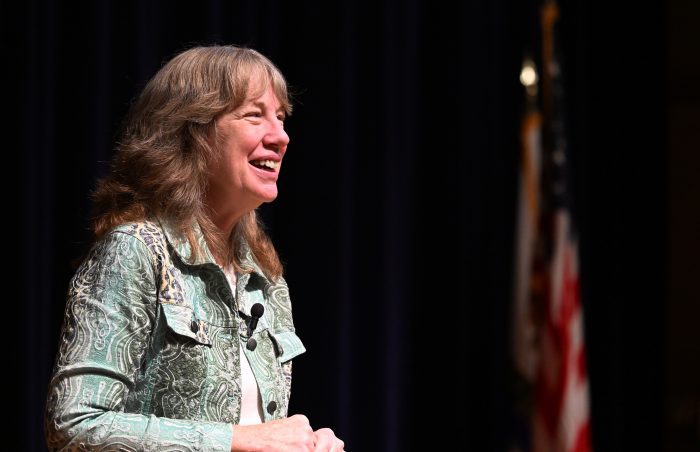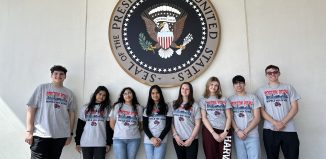EXCLUSIVE: Brookhaven National Laboratory’s new director discusses gardening, managing and new discoveries

In her first week on the job, JoAnne Hewett has been taking walks around campus — and she likes what she sees.
The first woman to lead the 76-year old Brookhaven National Laboratory, Hewett has explored a facility primarily funded by the Department of Energy that conducts groundbreaking research in Energy & Photon Sciences, Environment, Biology, Nuclear Science & Nonproliferation, Computational Sciences, Nuclear & Particle Physics and Advanced Technology Research.
The walks Hewett has taken have been “my way of learning where all the buildings are,” said Hewett in an exclusive interview with TBR News Media. “I truly love stumbling across things I didn’t know BNL had.”
One night, Hewett walked to an enormous greenhouse, which, as a gardener who enjoys growing tomatoes, chili peppers and citrus, intrigued her.
In meeting people at these facilities, Hewett has been “impressed” at “how dedicated they are to the mission and to the science that can be done here.”
Most recently the associate lab director for fundamental physics and chief research officer at SLAC National Accelerator Laboratory, Hewett brings extensive experience in theoretical physics to BNL and Stony Brook University, where she serves as Professor in the Department of Physics and Astronomy and Professor at the C.N. Yang Institute for Theoretical Physics.
Throughout her career, Hewett has been the first woman to serve in a host of roles. That includes as the first woman faculty member at SLAC in 1994, the first woman associate lab director and the first woman chief research officer.
“The best way to serve as a role model is to just do a good job at whatever it is you’re doing,” Hewett said.
In her many roles, Hewett has received numerous emails from students eager to meet her.
“Don’t get discouraged,” she tells them. “You’re going to get more roadblocks than others, potentially [but] hopefully not. Don’t get discouraged. Just keep working. If you love science and want to do science, if it’s the passion in your belly, just do it.”
Hewett has been successful in her career in part because she describes herself as “stubborn by nature.”
Cultural priorities
In her tenure as lab director for a facility with over 2,760 staff members, Hewett plans to emphasize the importance of creating a respectful work environment.
“It should be number one for everybody, everywhere to foster a respectful workplace environment, so that each person that comes into work in the morning or whenever they start their shift can do the very best that they can,” she said.
Additionally, she will stress the importance of safety at the Upton-based lab, where seven projects have led to Nobel Prizes.
“A good safety culture also promotes a good workplace environment,” said Hewett. “If you don’t do your work safely, you can’t do your work.”
Science vs. management
While research and management require the use of different parts of the brain, Hewett suggested her professional and administrative goals have overlapping approaches.
“In both cases, you need to be very strategic about your thinking,” she said. “When you’re doing research, you need to think about the best way to spend your time.”
She had a “ton” of ideas in theoretical physics and needed to be strategic about how she spent her time. As a manager, she also needs to be strategic about the programs she supports to ensure they are advancing.
In addition to creating a respectful and safe workplace, Hewett would like to delve into the beautification of the campus.
“I want to involve the staff” in that effort, she said.
Hewett served as a mentor from 2008 to 2011 for Rouven Essig when he was a postdoctoral researcher at SLAC.
In an email, Essig, who is now Professor of Physics at the C.N. Yang Institute for Theoretical Physics, described her as “an exceptional leader” who is “friendly and approachable” with a “clear vision.”
Essig lauded Hewett’s vision for recognizing the value of funding small-scale experiments in particle physics, which are low-cost but can enable “major discoveries,” he added. “I think this approach is having a big impact in particle physics research in the U.S. and elsewhere.”
Essig is “excited to see how she will further strengthen BNL and the connections to Stony Brook.”
Hewett has had “numerous important contributions to our understanding of physics beyond the Standard Model and how it can be discovered with experiments,” Essig added.
In her career, Hewett found it “terrifically exciting to discover something” in which she was the “only person in the world for that instant of time that knows something,” she said.
For her, that moment occurred when she was developing work on a particular theory of extra spacetime dimensions.
Collider appeal
Hewett came to BNL in part because of the ongoing construction of the Electron Ion Collider, which will study quarks and gluons in the nucleus and the strongest forces in nature.
“I did a lot of studies of potential future colliders,” said Hewett. “I’m excited to be at a lab where a collider will be built.”






